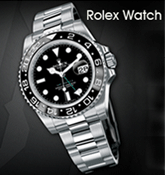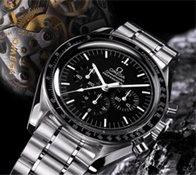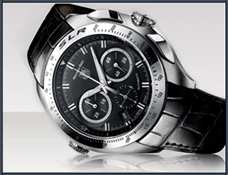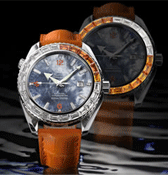Audemars Piguet Part 1 - A History of Performance
 Part 1 - A History of Performance
Part 1 - A History of Performance
In 2002, when Audemars Piguet wagered on victory by pinning its hopes on Alinghi and its crew, it did not yet imagine that the Swiss Challenger would be the first to bring the Silver Cup back to Europe.
Its choice proved to be judicious. In deciding to associate with this prestigious sailboat and
to accompany it in this legendary competition, the Manufacture was motivated by a conviction that the innovative spirit consistently demonstrated on all levels by Ernesto Bertarelli’s team is one of the fundamental ingredients of success.
Today, as the Cup stands proudly in the showcase of the Société Nautique de Genève, Alinghi and all those involved with the Defender are actively preparing for 2007 and the 32nd America’s Cup. All are keenly aware that, while this exceptional competition is an amazing human adventure, it most certainly rewards daring and excellence.
Georges-Henri Meylan
Following the current… of water and time
1851
Eager to challenge their English counterparts, a group of American yachtsmen belonging to the New York Yacht Club were invited, on the occasion of the Great Exhibition in London, to take part in the 100 Guinea Cup: this involved circling the Isle of Wight in a race against fourteen British yachts. The winner was the schooner America, duly claiming the trophy, a silver cup. This symbol of the New World’s victory over the British Empire was thus taken to New York, where it would remain for over a century.
1870
The principle of the Cup stipulated that the winner set the rules and host another event in order to vie for thetrophy. A British boat was thefirst to rise to the challenge.
1875
Jules-Louis Audemars and Edward-Auguste Piguet decided to unite their skills in order to conceive and produce watches with complex mechanisms. While the former handled commercial management of the company and travelled the world to establish direct contact with connoisseurs, the latter ran the technical side of the Manufacture. Loyal to
the demanding tradition of Haute Horlogerie, they focused on the creation of high-end models, while demonstrating impressive creative daring.
1892
So as to meet an order placed by Louis Brandt & Frère in Bienne, Audemars Piguet developed and completed the world’s first minute repeater wristwatch. With or without complex mechanisms, wristwatches were beginning to be fashionable.
1899
A tea magnate and the inventor of sports sponsorship, Sir Thomas Lipton became the first Challenger and commissioned the Shamrock. The Americans vied with it on
the Columbia, skippered by an exceptional helmsman and three-time winner of the Cup: Charlie Barr.
1930
Sir Thomas Lipton challenged for the fifth time with Shamrock V, facing off against Harold Vanderbilt’s Enterprise. Both complied with the rules ofthe Universal Rule which, by redefining the boat’s dimensions, heralded the predominance of design and technique. Withits aluminium mast and its 23 winches, the American Defender won the Cup and marked the start of the modern race. As it still is today, the race was fought out in real time.
1909
Made for Sir John Bennettin London, a “Grande Complication” pocket hunter-watch was created in the Audemars Piguet workshops. It is equipped with a grand and small strike, minute repeater and chronograph functions.
1929
The Manufacture proved capable of playing on Art Deco trends and evoking the effervescence of the Roaring Twenties in this jewellery pocket-watch with its geometrical shape. Crafted in platinum and set with baguette-cut diamonds, this precious horological gem is also equipped with a baguette movement.
Following the current… of water and time
1937
T.O.M. Sopwith challenged for the Cup with a boat that would take the J Class vessels to the peak of their development. Nonetheless, Endeavour II, designed using the aeronautical skills of the British manufacturer, was finally beaten by Ranger, the American Defender – albeit the latter was made at the end of the Great Depression at the least possible expense by buying up equipment from other teams. Moreover, for the very first time, the boat was rigged with sails made of synthetic fabrics.
1958
After World War II, the America’s Cup was reborn with the 12-Metre class boats, half as small as the J Class vessels and equipped with a more reasonable sail surface: 170 sq.m., compared with 700 sq.m. in 1937.
The reign of the 12-Metre class boats was to last around thirty years.
1946
With the Calibre 9’’’ML measuring no more than 1.64 mm thick, Audemars Piguet pushed the frontiers of the infinitely small by creating the world’s thinnest hand-wound wristwatch movement.
1957
The first Audemars Piguet wristwatch to be equipped with a perpetual calendar made
its appearance. This amazing timepiece displays the “regular” irregularity of the months, while taking account of leap years.
1970
In light of the Cup’s development and success, the New York Yacht Club authorised the participation of several Challengers. The latter vied with each other in a preliminary competition known since 1983 as the Louis Vuitton Cup.
1983
Won by Australia II, the America’s Cup changed hemisphere after
132 years of American domination. The winner then revealed the underside of the sailboat, equipped with the famous inverted winged keel.
1972
Completely overturning the existing codes of Haute Horlogerie, Audemars Piguet creates the Royal Oak, the first high-end steel sports watch, instantly recognisable thanks
to its guilloché dial, its octagonal bezel secured with eight hexagonal screws, and its integrated bracelet.
1986
Audemars Piguet introduced another world first in the shape of the first ultra-thin selfwinding tourbillon wristwatch. The tourbillon carriage, the smallest ever made, illustrated the Manufacture’s undisputed know-how in this field.
1988
Now back in the United States, the Cup was keenly coveted by New Zealanders who pulled a trick with an over 40-metre long monohull “rogue” Challenger boat.
But the Americans responded effectively with an 18-metre catamaran. This battle on water was pursued in the courts, and finally led to the definition of a new category: America’s Cup Class yachts.
1992
America’s Cup Class boats are spectacular high-tech machines handled by a sixteen-man sailing crew and sizeable logistic teams. Like the victorious America3,boats now make use of space-age technologies and cutting-edge materials such as carbon, kevlar and titanium.
1989
A treat for travellers! Audemars Piguet caused a sensation by launching the Dual Time, the first wristwatch to display the time in another time zone while being driven by a single selfwinding movement.
1994
Whereas only pocket-watches had thus far housed such a mechanism, Audemars Piguet incorporated it in a wristwatch and presented the first hand-wound grand and small strike movement with quarter repeater on two gongs.
1995
With the victory of Team New Zealand over the Americans in Stars and Stripes, the Cup flew
to Auckland for the very first time. For the first time in the history of the Cup, a boat called the Mighty Mary was sailed bya women’s team.
The Manufacture added a split-second chronograph to its triple complication model, thereby giving rise to the first selfwinding “Grande Complication” wristwatch.
2000
The first Swiss Challenger, named Be hAPpy in a nod to Audemars Piguet, vied for the America’s Cup. The Americans were eliminated by the Italians in the final race and the famous Silver Cup remained in Auckland.
Audemars Piguet’s enthusiasm for the nautical world gave rise to the Royal Oak City of Sails, dedicated to the first Swiss Challenger. In addition to the famous octagonal case and steel or titanium bracelet, it features a sapphire blue dial enhanced with yellow accents on the hands, hour-markers and outer minute circle.






 Part 1 - A History of Performance
Part 1 - A History of Performance







